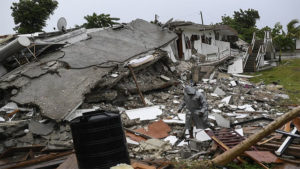 LES CAYES, Haiti — Heavy rain from Tropical Storm Grace on Tuesday forced a temporary halt to the Haitian government’s response to the deadly weekend earthquake, feeding the growing anger and frustration among thousands of people who were left homeless.
LES CAYES, Haiti — Heavy rain from Tropical Storm Grace on Tuesday forced a temporary halt to the Haitian government’s response to the deadly weekend earthquake, feeding the growing anger and frustration among thousands of people who were left homeless.
Grace battered southwestern Haiti, which was hit hardest by Saturday’s quake, and officials warned some areas could get 15 inches of rain before the storm moved on. Intermittent rain fell in the earthquake-damaged city of Les Cayes and in the capital, Port-au-Prince.
The rain and wind raised the threat of mudslides and flash flooding as Grace slowly passed over southwestern Haiti’s Tiburon Peninsula before heading toward Jamaica and southeastern Cuba.
The storm hit Haiti late Monday as the Civil Protection Agency raised the death toll from the earthquake to 1,419 and the number of injured to 6,000, many of whom have had to wait for medical help lying outside in wilting heat.
Patience was running out in the Western Hemisphere’s poorest nation. Haitians already were struggling with the coronavirus, gang violence, worsening poverty and the July 7 assassination of President Jovenel Moise when the quake hit.
Bodies continued to be pulled from the rubble, and the smell of death hung heavily over a pancaked, three-story apartment building. A simple bedsheet covered the body of a 3-year-old girl who firefighters had found an hour earlier.
Neighbor Joseph Boyer, 53, said he knew the girl’s family.
“The mother and father are in the hospital, but all three kids died,” he said. The bodies of the other two were found earlier.
Illustrating the lack of government presence, volunteer firefighters from the nearby city of Cap-Hatien had left the body out in the rain because police had to be present before it could be taken away.
Another neighbor, James Luxama, 24, repeated a popular rumor at many disaster scenes, saying that someone was sending text messages for help from inside the rubble. But he had not seen or received such a message.
A throng of angry, shouting men gathered in front of the collapsed building, a sign that patience was running out among people who have waited days for help from the government.
“The photographers come through, the press, but we have no tarps for our roofs,” said a man who refused to give his name. The head of Haiti’s office of civil protection, Jerry Chandler, acknowledged the situation.
Earthquake assessments had to be paused because of the heavy rain, “and people are getting aggressive,” Chandler said Tuesday.
Some children were orphaned in the quake and some youngsters were starting to go hungry, said Carl-Henry Petit-Frere, a field manager for Save the Children, which said it was distributing what it could to people living on the streets without protection from the wind and rain.
“I see children crying on the street, people asking us for food, but we are low on food ourselves as well,” Petit-Frere said, adding that children were warned not to go into houses because they could collapse. “The organizations that are here are doing what they can, but we need more supplies. Food, clean water and shelter are needed most, and we need them fast.”
About 20 soldiers finally showed up to help rescuers at the collapsed apartment building.
The lack of aid was made more apparent by the fact that the only help that arrived was from poorly equipped volunteers.
“All we have are sledgehammers and hands. That’s the plan,” said Canadian volunteer Randy Lodder, director of the Adoration Christian School in Haiti.
Sarah Charles, assistant administrator for the U.S. Agency for International Development’s Bureau for Humanitarian Assistance, said its disaster response teams were forced to suspend operations as the storm arrived, but members were back Tuesday to assess its impact and continue helping.
“We do not anticipate that the death toll related to this earthquake will be anywhere near the 2010 earthquake, where more than 200,000 people were killed,” Charles told reporters. The scale of the damage also was not as severe, she said.
The U.S. military’s Southern Command said it was moving eight helicopters from Honduras to Haiti and seven U.S. Coast Guard cutters were en route to support the aid agency team. Two cutters are already there along with two Coast Guard helicopters and Navy P-8 Poseidon aircraft that are taking aerial images of quake-devastated areas, it said.
The effort was being mounted “to provide the kind of emergency response that is necessary in a human tragedy and catastrophe like this,” U.S. national security adviser Jake Sullivan said at the White House.
Information for this article was contributed by Trenton Daniel and Christopher Sherman of The Associated Press.
